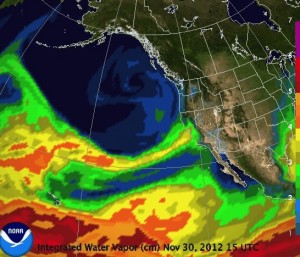
An atmospheric river is a narrow conveyor belt of vapor about a mile high that extends thousands of miles from out at sea and can carry as much water as 15 Mississippi Rivers. It strikes as a series of storms that arrive for days or weeks on end. Each storm can dump inches of rain or feet of snow.As you might guess, climate change is also involved. Evidence suggests that warming global temperatures could increase the frequency of atmospheric rivers. That, combined with the 200-year event expected soon and the fact we're learning so much much more about these storms, means that you should expect to hear the phrase "atmospheric river" more often.
The real scare, however, is that truly massive atmospheric rivers that cause catastrophic flooding seem to hit the state about once every 200 years, according to evidence recently pieced together (and described in the article noted above). The last megaflood was in 1861; rains arrived for 43 days, obliterating Sacramento and bankrupting the state.
Scientific American has two interesting stories on the phenomenon right now. The first, which I quote from above, is a blog post by Mark Fischetti. The second is a much longer feature story that gets into the forces that cause these storms and the climate change connection.

No comments:
Post a Comment